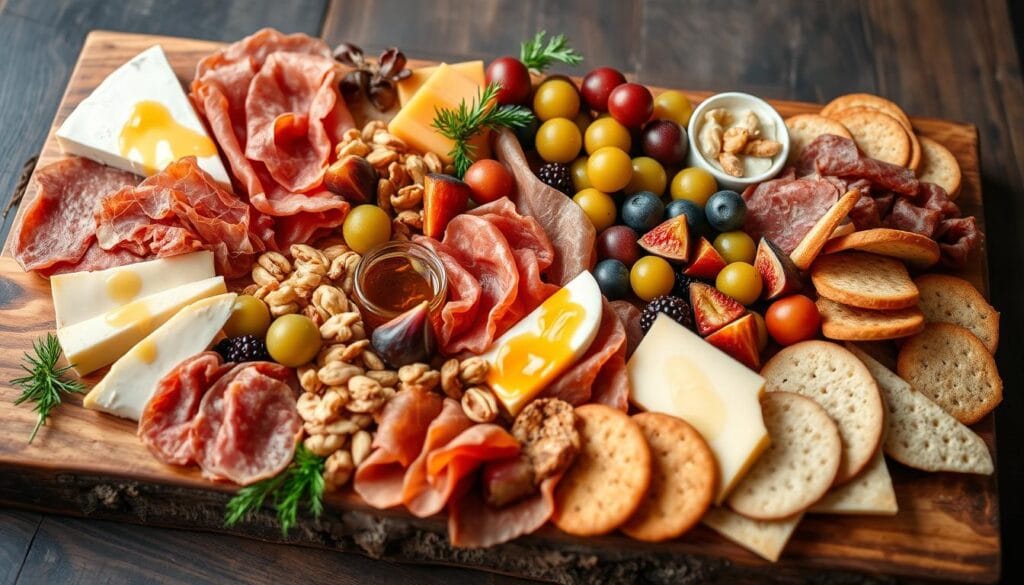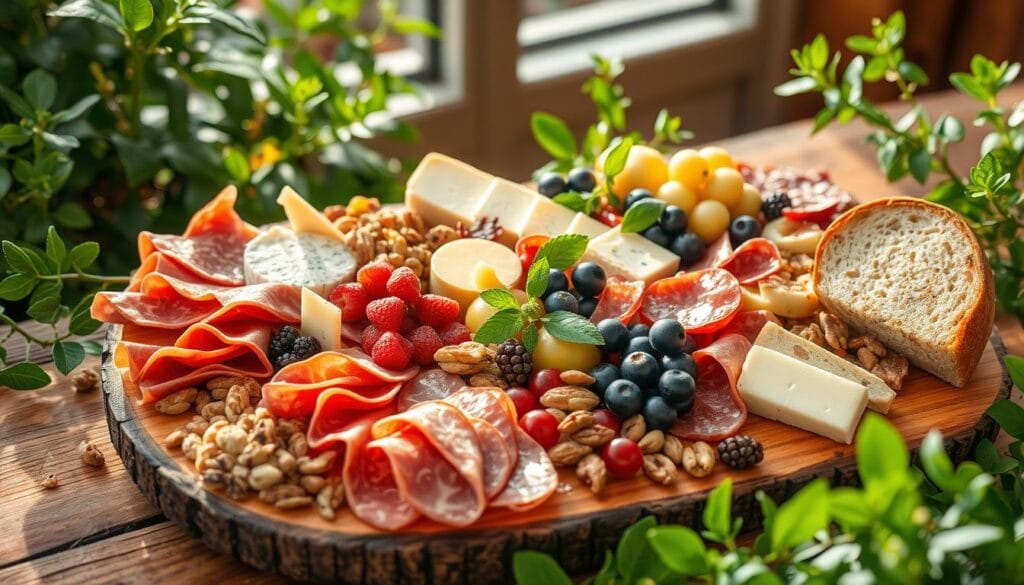Are you searching for a tasty and adaptable lunch? A charcuterie platter could be your ideal choice. These meat and cheese trays have evolved from fancy dining to a modern, flexible option. They cater to various tastes and health needs.
The way we serve antipasto allows you to make a snack board that’s all your own. It’s more than just a sandwich or salad. Charcuterie boards are full of proteins, cheeses, and other goodies. They offer a balanced and fun lunch that you can customize to your liking.
Table of contents
What is a Charcuterie Board?
A charcuterie board turns simple finger foods into a fancy appetizer spread. It delights guests and fills their bellies. This art form mixes meats, cheeses, and extras on a stunning platter, making every bite a feast for the eyes and taste buds.

The idea of charcuterie started in 15th-century France, focusing on meats. Now, it’s a flexible way to serve food that pleases many tastes and diets.
Definition and Components
A charcuterie board is more than food – it’s a fun experience. It includes:
- Cured meats
- Assorted cheeses
- Accompaniments and garnishes
- Crackers or bread
Common Ingredients
| Category | Recommended Items |
|---|---|
| Meats | Prosciutto, salami, chorizo, capricola |
| Cheeses | Manchego, brie, blue cheese, cheddar |
| Nuts | Almonds, pistachios, candied pecans |
| Fruits | Grapes, berries, dried apricots, figs |
Popular Additions to Consider
To make your charcuterie board even better, try these ideas:
- Sweet spreads like fig butter or honey
- Pickled vegetables
- Fresh herbs for garnish
- Artisanal crackers
“A well-crafted charcuterie board tells a story through its carefully selected ingredients and thoughtful presentation.”
Benefits of Eating a Charcuterie Board for Lunch
Looking for healthy lunch options? Charcuterie boards are a tasty choice. They’re packed with protein and easy to make. These boards mix nutrition, convenience, and flavor in a fun way.

Balanced Nutrient Profile
Charcuterie boards offer a great mix of nutrients. They have meats, cheeses, fruits, veggies, and nuts. This makes for a balanced and satisfying meal.
- 3-4 meat options for protein
- 2-3 cheese varieties
- Fresh fruits and vegetables
- Nuts and accompaniments
Customizable Meal Experience
Charcuterie boards are super flexible. You can change them to fit your taste and diet. Need something low-carb or gluten-free? A charcuterie board can be adjusted to meet your needs.
Effortless Preparation
Making a charcuterie board is easy. Just use 2-3 ounces of meat and cheese per person. Slice, arrange, and serve. It’s perfect for those with little time or cooking skills.
Transform your lunch routine with a stunning, nutritious charcuterie board that delights both eyes and palate!
Best Ingredients for Lunch Charcuterie Boards
Creating the perfect lunch charcuterie board is all about choosing the right ingredients. You want to mix flavors, textures, and health benefits. A good mix of cured meats, cheeses, and fresh produce can turn your lunch into a feast for the senses.
Delightful Meat and Cheese Selections
Start by picking a variety of proteins and cheeses for your board. Choose three to five cheeses to add depth and interest:
- Hard cheese: Aged cheddar or gouda
- Soft cheese: Creamy brie or camembert
- Blue cheese: Roquefort or gorgonzola
For cured meats, mix it up with:
- Prosciutto
- Salami
- Chorizo
- Coppa
Fresh Produce and Complementary Elements
Add fresh produce and accompaniments to your board. They bring color, nutrition, and balance to your meats and cheeses.
| Fruits | Vegetables | Accompaniments |
|---|---|---|
| Grapes | Cherry tomatoes | Whole grain mustard |
| Berries | Cucumber slices | Fig jam |
| Apple slices | Bell peppers | Honey |
Finishing Touches and Presentation
Add crackers, breadsticks, and nuts to finish your board. Pro tip: Remove cheeses from the fridge 30-45 minutes before serving to improve their taste and texture.
“A well-curated charcuterie board is like an edible work of art that delights all senses.” – Culinary Expert
How to Assemble a Lunch Charcuterie Board
Making a lunch charcuterie board turns your meal into a fun food presentation. It’s great for group lunches or just to entertain. Assembling a charcuterie board is easy and can impress anyone.
Step-by-Step Preparation Guide
Begin with a 24×24 inch board for plenty of space. Here’s how to make a beautiful lunch spread:
- Choose a large board or platter
- Put small bowls for olives and dips first
- Arrange cheese wedges neatly
- Roll meats into creative patterns
- Fill in gaps with fruits, veggies, and crackers
Professional Presentation Tips
Make your food look amazing with these expert tips:
- Use at least 3 different cheese types
- Make colors pop with fresh herbs and berries
- Play with textures and shapes
- Add garnishes like edible flowers
Group Lunch Sizing Considerations
Plan for groups by considering how much food you’ll need:
| Group Size | Recommended Quantities |
|---|---|
| Small Group (2-4 people) | 6-8 oz meat, 3-4 cheese types |
| Medium Group (5-10 people) | 12-16 oz meat, 5-6 cheese types |
| Large Group (10-20 people) | 24-32 oz meat, 7-8 cheese types |
“A well-crafted charcuterie board is like an edible artwork that invites conversation and sharing.” – Culinary Expert
Pro tip: Always have variety to cater to different tastes and dietary preferences!
Charcuterie Boards for Various Dietary Needs
Creating a charcuterie board that everyone can enjoy means thinking about different diets. Whether it’s for a party or a personal snack, knowing about plant-based options is key. This way, you can make a spread that’s fun for everyone.
Vegetarian Delights
Vegetarian charcuterie boards are full of life with their flavors and textures. Here are the main things to include:
- Soft and hard cheeses
- Roasted nuts
- Fresh and dried fruits
- Marinated vegetables
- Artisan crackers
Vegan Alternatives
With new plant-based options, making vegan charcuterie is simple. Here are some vegan board ingredients:
- Cashew-based cheese spreads
- Hummus varieties
- Roasted vegetable skewers
- Marinated tofu bites
- Seed and nut assortments
Gluten-Free Considerations
For those who can’t eat gluten, there are great alternatives. Here are some gluten-free options:
| Traditional Item | Gluten-Free Replacement |
|---|---|
| Wheat Crackers | Rice Crackers |
| Bread | Gluten-Free Bread or Vegetable Slices |
| Wheat-Based Dips | Homemade Vegetable Dips |
“Inclusivity is the secret ingredient in creating a memorable charcuterie experience.”
When making boards for guests with dietary needs, label everything clearly. Also, keep potential allergens separate. This way, everyone can enjoy the board safely.
Pairing Drinks with Your Charcuterie Board
Choosing the right drink can make your charcuterie board amazing. The perfect drink can match the rich tastes of meats and cheeses. This turns your meal into a special experience.
Wine Pairings that Delight
Wine pairing is an art that can make your charcuterie board even better. Different wines highlight the unique tastes of your meats and cheeses.
- Red Wines:
- Cabernet Sauvignon pairs perfectly with aged cheeses and cured meats
- Merlot complements prosciutto and salami
- Rose works wonderfully with lighter meats and soft cheeses
- White Wines:
- Chardonnay matches creamy brie
- Sauvignon Blanc enhances fresh cheeses
- Pinot Grigio works with light, delicate flavors
Non-Alcoholic Refreshing Beverages
Not everyone likes alcohol, so here are some great alternatives:
- Sparkling water with fruit infusions
- Artisanal iced teas
- Craft mocktails
- Flavored kombucha
Seasonal Pairing Suggestions
| Season | Recommended Drink | Flavor Profile |
|---|---|---|
| Summer | Rosé | Light, crisp, refreshing |
| Fall | Mulled Wine | Warm, spicy, comforting |
| Winter | Spiced Cider | Rich, warming, festive |
| Spring | Prosecco | Bright, celebratory, effervescent |
“The right drink doesn’t just accompany a charcuterie board – it transforms the entire tasting experience.” – Culinary Expert
When is a Charcuterie Board Appropriate for Lunch?
Charcuterie boards add excitement to your lunch. They turn a simple meal into a fun food experience. These boards are great for both lunch parties and office meals.
At home, a charcuterie board can make your weekend lunches special. You can mix three to five cheeses, cured meats, and fresh fruits and veggies. It’s a feast for the eyes and taste buds, perfect for family or friends.
Ideal Situations for Serving
Charcuterie boards are also a hit in the office. They make lunchtime meetings or client visits more engaging. With a mix of cheeses, spreads, and crackers, you can please everyone’s taste buds.
Workplace Lunch Ideas
Charcuterie boards are also great for outdoor events and picnics. They’re easy to carry and share, perfect for places where sitting down isn’t easy. By choosing a variety of foods and considering everyone’s diet, you’ll make your event unforgettable.
FAQ
Is a charcuterie board a good option for lunch?
Yes, a charcuterie board is a great lunch choice. It has proteins, healthy fats, and carbs for a nutritious meal. You can pick what you like, making it both tasty and pretty.
How much food should I prepare for a lunch charcuterie board?
Plan for 2-3 ounces of meat and cheese per person. For a main lunch, add a bit more. Make sure to have a variety of foods for everyone to enjoy.
Can I make a charcuterie board for special dietary needs?
Absolutely! Charcuterie boards can be for everyone. Vegetarians can enjoy cheeses, nuts, and fruits. Vegans can have plant-based cheeses and veggies. Just label everything clearly for guests with dietary restrictions.
What are the best cheeses to include on a lunch charcuterie board?
Pick cheeses with different tastes and textures. Cheddar is sharp, brie is creamy, and gouda is mild. Manchego adds a unique flavor. Mix soft, hard, and aged cheeses for a great taste.
What drinks pair well with a charcuterie board?
Wine is a classic choice. Sauvignon Blanc goes with soft cheeses, while Cabernet Sauvignon pairs with aged cheeses and meats. For non-alcoholic options, try sparkling water, iced tea, or artisanal sodas. In summer, rosé is perfect, and mulled wine is great in winter.
How far in advance can I prepare a charcuterie board?
Prepare most of the board 1-2 hours before. Let meats and cheeses warm up for 30 minutes. Cut fruits and veggies just before serving. Store items in the fridge and set up the board right before eating.
Are charcuterie boards expensive to create?
The cost depends on the ingredients you choose. You can save money by picking affordable cheeses and meats. Use seasonal produce and mix high-end items with cheaper ones. Shopping at local markets or in bulk can also help.

